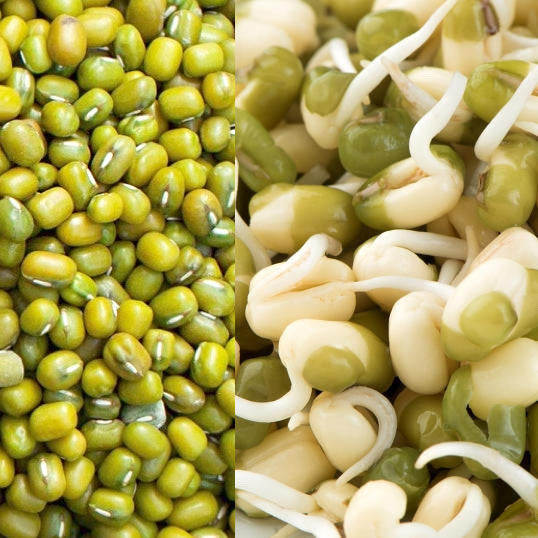Mung beans (vigna radiata), also called 'moong' in South Asia, are small green dried beans that belong to the legume family. They are an integral part of many forms of Asian cuisines
Gut health is an important indicator of good health. The age-old Ayurvedic wisdom that "gut health is brain health" is now being proven by science in The Brain-Gut Connection.
FIVE REASONS WHY MUNG (MOONG) BEANS AID GUT HEALTH
- They're a prebiotic that restores your gut microbiome
- They're high in soluble fibre and resistant starch making them easy to digest. Just one serving of mung bean stew has 30% of daily fibre needs.
- They're the most easiest-to-digest bean because when cooked they are gentle, soft and moist making them easy to move through the guts.
- The carbs in mung beans cause less flatulence than other legumes.
-
Soaking and sprouting mung beans leaches out the lectins (anti-nutrients) and boosts nutrition making them even more easy for digestion.
- Mung beans are a excellent source of digestible plant-protein because they are high in low-acid forming plant-protein. Not all proteins are easy to digest.
MUNG BEAN PROTEIN OR MEAT PROTEIN?
- Red meat and eggs contain carnitine, a compound that when broken down by gut bacteria, forms a substance that's been linked to hardening of the arteries.
- Most animal-based protein sources contain saturated fatwhich is less healthy than unsaturated fat.
- Plant-based protein sources (beans and nuts) also include healthy unsaturated fats and fibre, both of which help lower harmful LDL cholesterol levels.
- According to Harvard Medical School, plant protein may offer some long term health benefits.
-
Fibre also helps lower blood pressure.
THREE WAYS MUNG BEANS SUPPORT WEIGHT MANAGEMENT
- Mung beans are a low-calorie and low-glycemic index food
- Soaking and sprouting mung reduces long-chain sugars/carbs
- Mung beans release hormones that make us feel full, so we eat less slashing out calorie intake.
- They're gluten-free with easy to digest plant-protein
TEN WAYS MUNG BEANS ARE A DIETARY POWERHOUSE
- Mung beans are high in important vitamins, minerals, proteins and fibre
- High folate: 80% of the Reference Daily Intake (RDI) per cup
- Protein: 14 grams per cup
- Fibre: 15 grams
- Manganese: 30% the RDI
- Magnesium: 24% of the RDI
- Vitamin B1: 22% of the RDI
- High in antioxidants which may protect against free radical damage
- Antioxidants may prevent heat stroke
- May lower ‘bad’ LDL cholesterol, reducing heart disease risk
- Rich in potassium, magnesium and fibre which may reduce blood pressure
- Fibre and resistant starch aid digestive health
- Nutrient composition may lower blood sugar levels
- May promote weight loss by suppressing hunger and raising fullness hormones
- Folate in mung beans can support a healthy pregnancy
- Versatile and easy to add to your diet
Read more here: https://www.healthline.com/nutrition/mung-beans
Mung Beans: the Queen of Beans in Ayurveda
In Ayurveda, mung beans are considered the Queen of Pulses and a superfood because of these tiny mighty mung beans are chock full of micronutrients. Of the legume family, it is the lightest and easiest to digest, the least gas forming and has a Sattvic effect on the mind.
From a western perspective, mung beans are considered alkaline food because they have high quantities of predominantly alkaline minerals – calcium, magnesium, potassium and sodium, plus they are rich in Vitamin C and folate. When cooked with rice, mung beans provide a complete protein with all your essential amino acids.
Ayurveda means 'Science of Health and Life'
The philosophy of Ayurveda is to balance the energies of our body and mind through nature and with nature.
Ayurveda is the world's oldest system of health and healing developed in India more than 5,000 years ago. It is considered the 'Mother of All Healing'. [4]
The philosophy of Ayurveda is that everything in the universe is inherently connected. Our body, mind and environment too are intimately connected. Ayurveda focuses on ways to live in harmony with the universal forces inside and outside of ourselves. This means maintaining a healthy lifestyle, through nourishing foods, yoga, meditation and emotional wellbeing. When something disrupts this balance, we get sick and experience 'dis-ease’.
The practice of Ayurveda places great emphasis on preventing dis-ease, rather than fighting disease, and proactively balancing the three life energies (called doshas, or constitutions) within each of us: air (vata), fire (pitta), and earth (kapha). Each type of life energy controls a different part of our body and even different aspects of our mind.
Visit the Ayurveda Institute to learn more about Ayurveda.
GET CREATIVE WITH MUNG (MOONG) BEANS
Versatile, distinctive and subtly sweet. Mung beans can enhance any menu with flavours that are savoury, spicy, creamy, sweet and much more. You can:
- Sprout it and add it to salads and stir fry
- Soup it - make a hearty, delicious soup with a meal or on its own. This is called 'daal' in Indian cuisine.
- Make khichari (also called khichdi, kitchari) is an Indian-style risotto made with a blend of mung beans and rice, and gentle spices.
- Make stuffed rotis/naans/breads/buns - cook mung in a dry form, flavour and stuff in your choice of buns. With lots of ghee on these rotis, it's heavenly!
- Make desserts – turn this humble bean into cakes, puddings, sweets, and creamy desserts with coconut milk.
- Don't forget your Moong Pani Sipping Broth on the go! A simple, easy and healthy way to enjoy mung bean in a cup. Quench your thirst and satiate your hunger.
Linking Disclaimers
By providing links to other websites as mentioned in the articles on this page, does not guarantee, approve, or endorse the information or products available on these sites.
References:
https://www.healthline.com/nutrition/mung-beans
https://draxe.com/mung-beans-nutrition/
https://foodtolive.com/healthy-blog/mung-beans-benefits-nutrition-facts-recipes/
https://food.ndtv.com/food-drinks/8-ayurvedic-spices-that-can-help-boost-your-digestive-fire-agni-1737380
https://www.webmd.com/balance/guide/ayurvedic-treatments#1
https://www.muditainstitute.com/resources/blogs/happybelly/mungdaal.html
[i] https://www.self.com/story/sneaky-cause-of-bloating-protein-bloat
https://www.mapi.com/ayurvedic-knowledge/meal-planning/ayurvedic-protein-sources-beans-lentils-dahls.html
https://www.livestrong.com/article/28321-easytodigest-high-protein/
[2] https://www.health.harvard.edu/nutrition/ask-the-doctor-best-protein-animals-or-plants
[3] https://www.muditainstitute.com/resources/blogs/happybelly/mungdaal.html
[4] https://www.ayurveda.com/resources/articles/ayurveda-a-brief-introduction-and-guide









